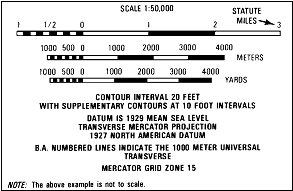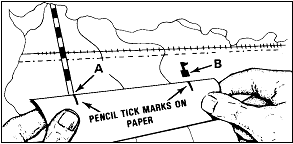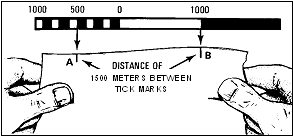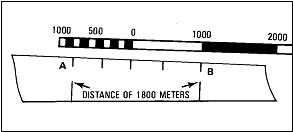Measure Distance On A Map
CONDITIONS
Given a standard 1:50,000 military map, a strip of paper or a straightedge, and a pencil.
STANDARDS
1. Determine the straight-line distance, in meters, between two points with no more than 5 percent error.
2. Determine the road (curved-line) distance, in meters, between two points with no more than 10 percent error.
TRAINING AND EVALUATION
Training Information Outline
Note: Soldiers can use their maps to measure the distance between two places. The maps are drawn to scale. This means that a certain distance on a map equals a certain distance on the earth. The scale is printed at the bottom and top of each map (Scale 1:50,000). This means that 1 inch on the map equals 50,000 inches on the ground. To change map distance to miles, meters, or yards, use the bar scales at the bottom of the map (Figure 5-29).
Figure 5-29. Bar scales.

Figure 5-30. Measurement of distance.

a. Take a ruler or the edge of a piece of paper and mark on it the straight-line distance between your two points (Figure 5-30).
b. Then, put the ruler or the paper just under one of the bar scales and read the ground distance in miles, meters, or yards. The bar scale in Figure 5-31 shows a ground distance of 1,500 meters.
Figure 5-31. Determination of distance.

c. Suppose you want to find the distance between A and B around a curve in a road. Take a strip of paper, make a small tick mark on it, and line up the tick mark with point A. Align the paper with the road edge until you come to the curve, make another mark on the paper and on the map, and then pivot the paper so that it continues to follow the road edge. Keep repeating this until you get to B. Always follow the road edge with your paper. Make a mark on your paper where it hits B, and then go to the bar scales to get the distance (Figure 5-32).
2. Normally, you will be required to measure distance in meters, and you may receive a problem that goes off the bar scale. The meter bar scale allows you to measure distances up to 5,000 meters. If you have to measure distances greater than 5,000 meters, follow this procedure:
a. Place your starting point on the paper under the zero on the bar scale. Measure off 4,000 meters and place a new tick mark at the point on your paper.

Figure 5-32. Map distance 1,800 meters.
b. Place this second tick mark also under the zero on the bar scale and determine if the distance on the paper now falls within the bar scale. If it does, add this value to 4,000 to give a total distance. If it does not, repeat the last step (a) until the distance on the paper falls within the bar scale. Remember to add this last value to the total number of meters you have already measured.
Evaluation Guide:
Measure Distance on a Map
Performance Measures
1. Measure the straight-line distance on the map using the straightedge.
2. Place the paper under the meter bar scale.
3. Determine the distance with no more than 5 percent error.
4. Measure the curved-line distance using the strip of paper.
5. Place the paper under the meter bar scale.
6. Determine the distance with no more than 10 percent error.